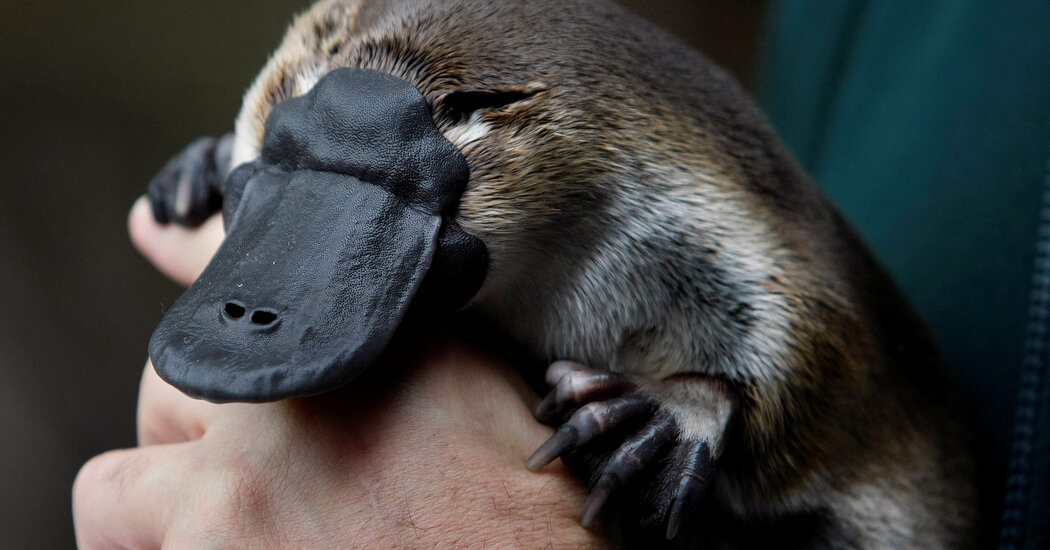When the British zoologist George Shaw first encountered a platypus specimen in 1799, he was so befuddled that he checked for stitches, thinking someone might be trying to trick him with a Frankencreature. It’s hard to blame him: What other animal has a rubbery bill, ankle spikes full of venom, luxurious fur that glows under black light and a tendency to lay eggs?
Centuries later, we’re still trying to tease the platypus apart, now with subtler tools. What we find may lead us to ask: Is the platypus normal, and are we the thing that turned out strange?
On Wednesday in Nature, researchers presented the most complete platypus genome yet assembled, along with the genome of a close relation, the short-beaked echidna. By diving into their DNA, researchers can uncover the genes and proteins that underpin some of these creatures’ distinctive traits, and better understand how mammals like us evolved to be so unlike them.
The platypus and four echidna species, all native to Australia, are the world’s only living monotremes — a group perhaps best known for their unique reproductive strategy, which involves laying eggs and then nursing their young once they’ve hatched.
“They are very bizarre in many ways,” said Guojie Zhang, a genomicist at the University of Copenhagen and a leader of the sequencing effort.
But because the monotremes diverged from other mammals so early — about 187 million years ago — they are also “very important for understanding mammalian evolution,” he said. Indeed, some monotreme traits that seem so strange to us may have actually been present in the ancestor we all share.
The platypus genome was first sequenced in 2008. Since then, improvements in technology have made it much easier to map the placement of particular genes onto chromosomes. In the earlier attempt, only about 25 percent of the platypus genome was contextualized in such a way, Dr. Zhang said, while the new version is 96 percent mapped.
“It’s very complete,” he said. “We find a lot of genes that have been missed in previous assemblies.”
The new genomes validate many previous findings about the platypus and, combined with the new echidna genome, “add much more clarity to the evolutionary mechanisms involved,” said Wesley Warren, a professor of genomics at the University of Missouri, who led the 2008 sequencing study but was not involved in this one.
“In my opinion, among mammals, the platypus is the most fascinating species of all,” he added. “They represent the ancestral state of what terrestrial mammal genomes could have been before adapting to various environments.”
Having such a comprehensive map enables comparisons among the genomes of different species, and helps fill gaps in the step-by-step story of how mammals appeared and then diverged. For instance, many birds and insects have multiple copies of a gene called vitellogenin, which is involved in the production of egg yolks.
Most mammals don’t have the vitellogenin gene, said Dr. Zhang. But the new genomes reveal that platypuses and echidnas have one copy of it, helping to explain their anomalous egg-laying — and suggesting that this gene (and perhaps the reproductive strategy itself) may have been something the rest of us lost, rather than an innovation of the monotremes. Meanwhile, they also have milk-producing genes similar to ours and those of other mammals, allowing them to nourish their young.
Other traits took other paths. The new genome reveals that monotremes, which are toothless, have lost multiple genes associated with dental development that are present in other mammals. Platypuses also have venom-producing genes that other mammals lack, but that are similar to those found in some reptiles, perhaps explaining their toxic foot spikes.
Less visible, but equally perplexing, is the fact that while other mammals generally have one pair of sex chromosomes, monotremes have five pairs. The structure of the newly revealed genomes suggests that these sex chromosomes were once in a ring formation, and then broke into pieces — although more research is needed to figure out how that happened.
Dr. Zhang and his colleagues plan to continue investigating the many monotreme mysteries that remain. “They are a very important lineage to understand,” he said.
Source: Read Full Article
